Guide to Agile Planning in 2025: Processes, Tools and Templates
If you’re looking to move away from the overflow of documents and strict planning guides that traditional project management methodologies require in favor of adopting a free-flowing, adaptable method that encourages communication, agile planning is for you.
Agile project management has grown in popularity in recent years. In fact, at least 71% of U.S. companies1 use agile planning methods to map out their projects. It should be no surprise that companies are finding success by utilizing the best project management software and adopting agile approaches.
If you want to increase project success but aren’t sure what agile is, you’re in the right place. In this guide, we’ll break down agile planning and explain the stages of the agile process. We’ll explain the difference between traditional planning and agile planning, discuss the key components of agile and cover what the agile manifesto says about planning. Let’s jump in.
-
06/26/2024
Updated the article to add custom graphics.
Definition: What Is Agile Planning?
In agile planning, projects are broken down into chunks of work that lead to a product vision and can be handled in a flexible manner. Agile planning enables project teams to formulate a plan of attack for upcoming projects while also allowing room for changes as the projects progress.
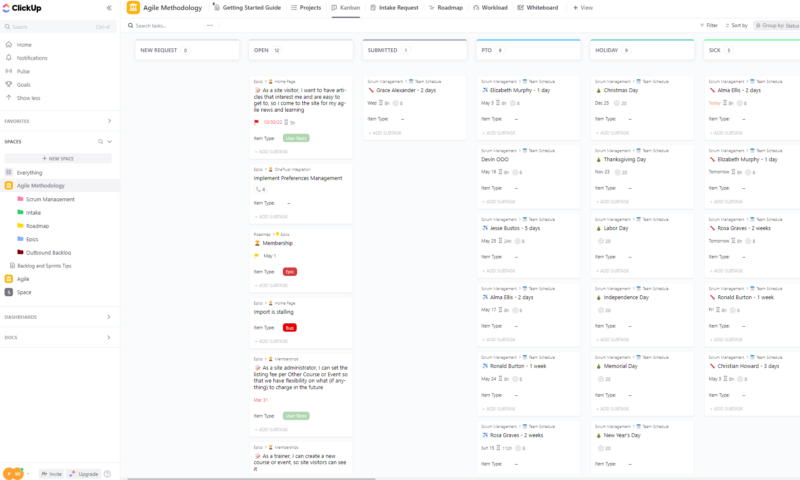
Traditional project management methodologies like waterfall use project plans that are set in stone. Agile planning involves sitting down with stakeholders and clients at the beginning of the project, after each sprint and at the end of the project so feedback on iterations can be shared and changes can be implemented frequently.
Avoid Costly Project Management Mistakes – Get Free Tips Today!

- Discover 10 fundamentals of project management
- Understand step-by-step plans for PM execution
- Learn tips to avoid 5 common mistakes by beginners
Methods & Techniques in Agile Planning
Below, we’ll examine several popular agile planning methods in more detail so you can better understand how each method works.
What Is PI Planning in Agile?
Project increment (PI) planning in agile is similar to sprint planning and allows agile release trains to plan large-scale sprints that last between eight and 12 weeks. PI planning relates specifically to a version of planning used in the SAFe method, which is a type of scaled agile.
What Is Sprint Planning in Agile?
During a sprint planning meeting, the product owner and the development team create user stories (tasks) to work on, and create definition of ready (DoR) and definition of done (DoD) strategies to ensure that the items being worked on are in the best shape possible. Sprints are a key component of scrum and these sprints are time-boxed events and the sprint duration can last one to four weeks.
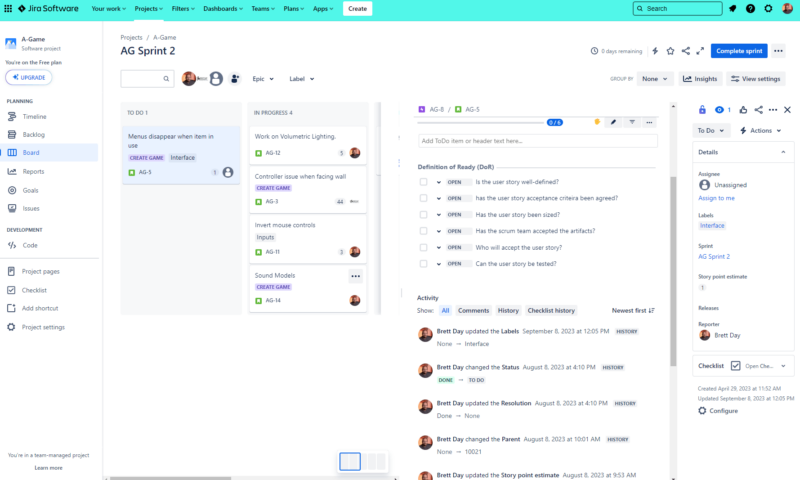
What Is Capacity Planning in Agile?
Capacity planning is where tasks are assigned values like story points to determine which resources are required to finish the job. An agile team can also use various agile estimation techniques, like planning poker or t-shirt sizing, to estimate the effort required to complete a task.
It’s a popular method that many agile teams use. Thanks to the reports that many of the best agile tools provide, project managers, scrum masters and product owners can see how much work their team has been able to finish (known as team velocity) in time-boxed events.
Capacity planning leads to well-planned sprints and time-boxed events. You can read our capacity planning vs resource planning guide to see how the two compare.
What Is Adaptive Planning in Agile?
Adaptive planning involves regular meetings and adjustments to the existing plan, allowing teams to be flexible. Project leaders who embrace adaptive planning can quickly change the team’s direction to meet new requirements and goals that stakeholders and clients set and request. Adaptive planning is the backbone of agile methodologies and frameworks.
What Are the Stages in the Agile Planning Process?
The stages of agile projects can vary depending on the framework and technique you use to lead your team. Below, we’ll examine the popular agile planning onion technique.
Agile Planning Onion
The agile planning onion is a project visualization tool that can help project managers navigate through six planning stages: strategy, portfolio, product, release, iteration and daily. Each layer of the onion relates to a portion of agile planning.
When using the agile onion, you start with the outer layer and work your way in. The outer layers represent items or tasks that occur less frequently, while the inner layers represent more frequent processes. Below, we’ll look at the stages in more detail.
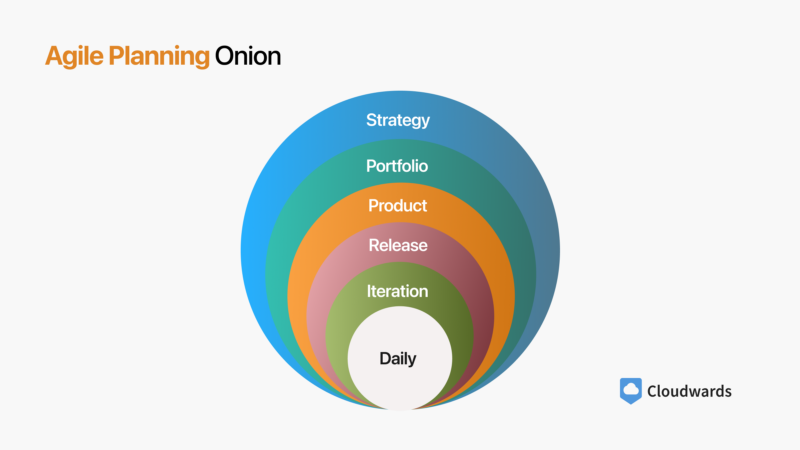
Strategy
The onion’s outer layer represents the overall strategy that agile project managers want to use and the project’s goals. During this stage, senior leaders, stakeholders and clients create a project charter (project scope) that defines the vision. Project resources and ways to reach project objectives are also discussed.
Portfolio
During the portfolio part of the onion process, project leaders manage their portfolio of projects and discuss prioritization, resource allocation and how the project visions align with business objectives. Project roadmaps are also developed.
Product
When teams reach the product layer, the senior leaders decide on which software development approach to use, and timelines, due dates and themes are set. Feature priorities are also finalized.
Release
Teams hold release planning discussions to decide how many sprints or time-boxed events there will be, determine which product features (user stories) will be included in each sprint and set team velocities (capacities).
Iteration
The fifth layer, iteration (sprint planning), is when the product owner and development team meet to discuss and define the definitions of ready and done, as well as the acceptance criteria. In addition, teams assign story points to each task or use other agile estimation techniques to determine how complex a user story is. Delegation poker can also be used to assign tasks.
Daily
The innermost layer, daily, represents the daily meetings during which teams discuss the project, the tasks they’re working on and any issues or successes they’re experiencing. Daily meetings are one of the most critical agile project management practices, as they help teams stay focused on the project.
Agile Planning vs Traditional Planning
Traditional project management approaches differ significantly from agile methodologies and frameworks. In traditional methodologies like waterfall or the critical path method (CPM), projects are planned down to the last detail before work begins. Teams do not deviate from the plan, and product testing is one of the final steps.
Agile methodologies easily meet the changing needs of stakeholders and clients. If the market changes or a key new feature is needed, teams can easily stop, pivot and realign themselves with new goals. Agile teams also frequently test each new iteration of the software or product they’re working on to iron out bugs and issues.
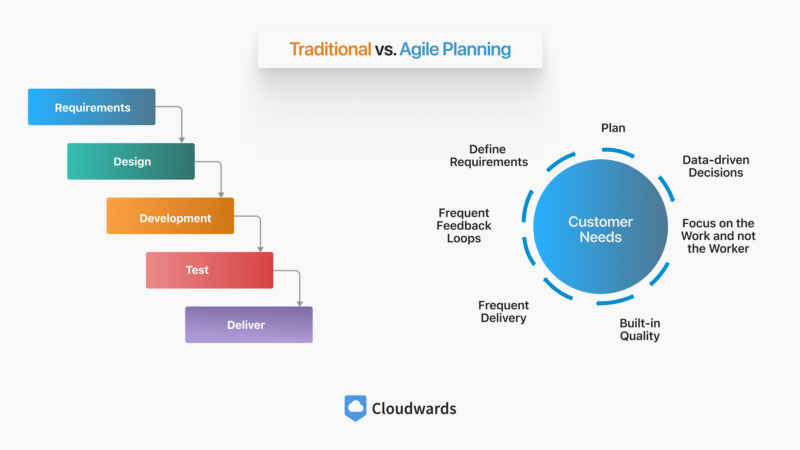
Agile Planning Tools & Software
Fortunately, the days of using sticky notes on a whiteboard are behind us. Now, many project management software platforms can help us plan, track and manage projects with ease, like these free project management software options. Below, we list five of our favorite agile project management tools to help modern teams get the job done.
- monday.com: Our favorite agile project management tool is capable of supporting all agile frameworks. monday.com is easy to use, is loaded with features and offers affordable plans. Learn more in our monday.com review.
- ClickUp: A powerful platform for agile methodology, ClickUp is unmatched when it comes to collaboration tools and has easy-to-use task management features. Find out more in our ClickUp review.
- Zoho Projects: This is the ideal platform for new project teams due to its intuitive, agile-friendly interface; integrations with other Zoho products; and powerful chat tool. Read our Zoho Projects review to learn more.
- Trello: Trello features the best kanban boards in the industry. Its drag-and-drop mechanics and customizable task cards are unmatched. Trello also supports unlimited integrations. You can learn more in our full Trello review.
- Jira: Perhaps the best tool for agile software development, Jira’s backlogs, issue trackers and boards are unmatched. Check out our Jira review for more details.
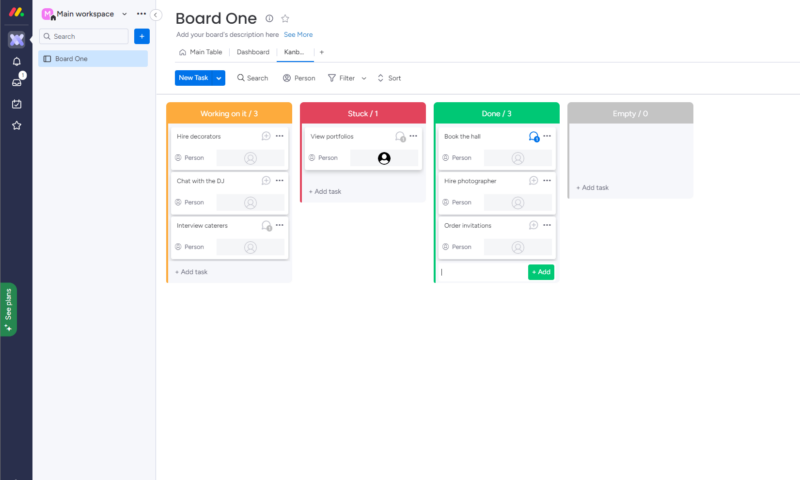
thanks to its easy-to-use workflow tools and affordable plans.
Agile Planning Template
Project management software can help you plan and execute projects, but you can find yourself in a bind if you don’t know how to get the most out of the software. Fortunately, platforms like monday.com come with numerous templates that can help you quickly get projects up and running. Below, we’ll take a look at some popular monday.com agile planning templates.
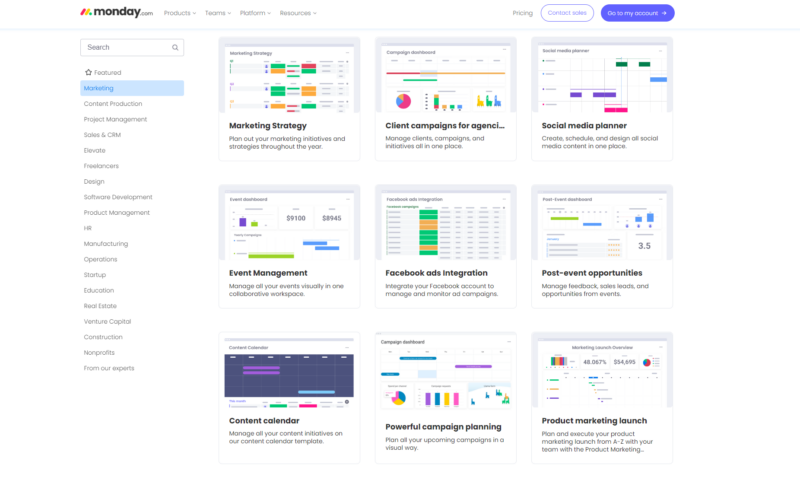
project in any industry up and running with just a few clicks.
Software Development Templates
monday.com is ideal for agile project teams working on software development projects. monday.com offers many templates that can help the entire team execute a project, move through the iterative process and realize the project vision. You can find templates for sprint planning, sprint retrospectives, product roadmaps, features, releases and more.
Human Resources Templates
Many human resources teams have switched from traditional project planning to agile planning, and for good reason. monday.com knows this and supplies templates for kanban boards to help human resources professionals breeze through the recruitment process, onboard new employees and much more.
Marketing and CRM Templates
monday.com tops our list of the best project management software for CRM because of its templates. There are templates for event management, social media campaigns, content calendars, marketing activities, customer onboarding and sales. You can activate the templates with a single click and use them as they come or customize them to your liking.
Browse through the extensive list of templates. You’ll find solutions for freelancers, startups, content production, education, real estate and many more industries. If you’re a project manager, scrum master or team member who wants to get a head start when it comes to managing projects and strive for continuous improvement, templates are the way to go.
How Does the Agile Manifesto Address Planning?
The agile manifesto champions the idea of welcoming changes, even late in the development process; frequently delivering functional software; using working software as the main method of measuring progress; and promoting daily collaboration among developers.
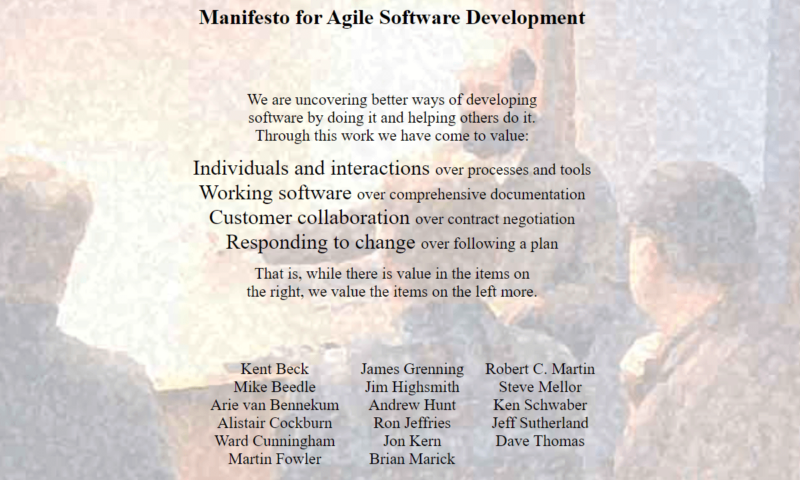
methods created the agile manifesto.
Created by a group of software developers who were tired of the restrictive waterfall project management method, the agile manifesto is quite clear about how to approach planning with the agile methodology. In agile projects, you put the customer first in everything you do. It also states that teams must meet regularly to reflect on progress and adjust their behavior accordingly.
Key Components of Agile
Now that you know what agile planning is, it’s time to take a more in-depth look at some key components of the agile planning process. We list four important components that should never be overlooked.
Face-to-Face Meetings
No matter which agile framework or method you use, you should expect to participate in face-to-face meetings. The agile manifesto makes it clear that for projects to be successful, open and honest discussions between team members, stakeholders and clients should frequently take place. Communication and collaboration are the keys to any agile project plan.
Backlog Refinement
Backlog refinement is the process of updating, prioritizing and analyzing user stories and tasks to work on in upcoming sprints and time-boxed sessions. By ensuring that user stories are complete, that new client and stakeholder requests have been added, and that every development team member is in agreement, sprints and work periods run smoothly.
Agile Tools
We’ve discussed project management software and how it can help you set project goals, but kanban and scrum boards are worth mentioning. These agile boards give leaders a global overview of a project. Easy-to-read columns that house task cards can show which part of the development process a task is in and whether team members are being over- or underutilized.
Sprints and Time-Boxed Events
A key component of agile planning is breaking down large projects into small, easily manageable periods of work that last from one to four weeks. By breaking down projects, teams can focus on high-priority tasks and managers can efficiently track team velocities. Time-boxed events allow development teams to frequently deliver working software and product iterations.
Characteristics of Agile Planning
Agile planning can greatly enhance the probability of project success. Once your team has adapted to the process, you can expect the following benefits.
- Increased collaboration: Thanks to the nature of agile, teams are encouraged to communicate openly and work together to solve problems. Increased collaboration leads to better end products.
- Higher-quality products: Teams can create higher-quality products for their clients thanks to improved collaboration and communication, better user stories and concise definitions of ready and done.
- Continuous feedback: In agile frameworks, stakeholders and clients become part of the team. This increases the amount of input they can give the team, which means the client has a greater chance of ending up with the product they envisioned.
- Continuous improvement: Teams that adopt agile approaches are more likely to continually learn thanks to frequent meetings and feedback loops.
- Improved customer focus: Frequent meetings with stakeholders and clients help the team understand exactly what the customer or stakeholders want. The customer-first approach to product development appeases clients and drives customer value.
Final Thoughts
There’s no doubt that abandoning traditional project management practices and adopting an agile approach to planning can pay off in a big way, especially in the product and software development industries. Agile frameworks allow teams to pivot quickly, factor in requests that are outside of the original project scope, collaborate efficiently and plan better.
If you want to know more about Agile, you can read our Agile Iron Triangle guide or our list of Agile interview questions.
Have you considered adopting an agile planning approach? Do any agile frameworks (scrum, kanban, XP) pique your interest more than others? Have you discovered any other benefits since switching to agile planning? Let us know in the comments, and as always, thanks for reading.
FAQ: Agile Strategic Planning
The six levels of the agile onion method for planning are strategy, portfolio, product, release, iteration and daily.
The stages of agile planning are the same as the levels of agile planning: strategy, portfolio, product, release, iteration and daily.
The agile method for project planning adopts a highly adaptable, flexible and iterative approach. After creating an initial project scope, agile frameworks allow for significant changes throughout all project stages.
Agile strategic planning borrows many elements from agile software development, such as creating product visions, embracing change, holding frequent meetings for reviews and self-reflection, and being open to continuous feedback from stakeholders and clients.
Sources:


